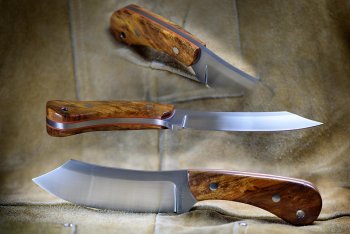One other 'gotcha' that kicked my butt for a long time during hand sanding: change your paper towel whenever you change grits. I don't know how anyone else does it, but I wipe the blade just about every time I toss a worn piece of sandpaper. I like to wipe off the oil and swarf to see where my scratches remain. Of course that paper towel is full of say 320 grit. When I'd go to 600 grit I'd keep wiping with my same paper towel. Well, duh! There isn't much point in sanding to 600 if you're just going to rub loose 320 grime across the the blade again. Of course you never see the scratches until you're up around 1500 grit and wondering where you went wrong.
The other thing I learned to do above 600 grit is to shoot the blade with windex before wiping. When you are looking for that nice even finish, wiping your grit down the blade with a paper towel causes those crazy lines. Think about how hard it is to get all of those intentional scratch lines to flow in the same direction for that even pattern, trying to drag draw your sandpaper in the straightest line possible. Then you grab that shop towel and wipe it... all that residue and invisible grit still stuck on the surface or in the towel gets wiped willy nilly down the perfect finish you just created. doh! Shooting the blade with windex first helps to lift that grit-infused residue off the surface and then a careful wipe removes it.


